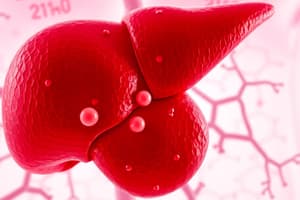Podcast
Questions and Answers
Which organ is inherently susceptible to toxicity from xenobiotics due to its role in metabolizing and eliminating drugs?
Which organ is inherently susceptible to toxicity from xenobiotics due to its role in metabolizing and eliminating drugs?
- Liver (correct)
- Heart
- Kidney
- Lung
What percentage of cases of acute liver failure (excluding APAP) is drug-induced liver injury responsible for?
What percentage of cases of acute liver failure (excluding APAP) is drug-induced liver injury responsible for?
- 13% (correct)
- 7%
- 20%
- 1%
What is the main focus of the Drug-Induced Liver Injury Network Group in the United States?
What is the main focus of the Drug-Induced Liver Injury Network Group in the United States?
- Enhancing knowledge of drug-induced liver injury causes and outcomes (correct)
- Studying respiratory diseases
- Researching genetic predispositions for liver diseases
- Improving understanding of drug-induced heart disease
What is the mechanism of drug-induced cholestatic injury?
What is the mechanism of drug-induced cholestatic injury?
Which substance is directly linked to fulminant hepatic failure?
Which substance is directly linked to fulminant hepatic failure?
What is the ratio of ALT to ALP that indicates hepatocellular liver injury?
What is the ratio of ALT to ALP that indicates hepatocellular liver injury?
Which enzyme is more liver-specific compared to AST?
Which enzyme is more liver-specific compared to AST?
Which enzyme is found primarily in the hepatobiliary tract, bone, and placenta?
Which enzyme is found primarily in the hepatobiliary tract, bone, and placenta?
Which blood clotting indicator's synthesis occurs in the liver?
Which blood clotting indicator's synthesis occurs in the liver?
Which blood component is the end product of heme breakdown and is bound to albumin in serum?
Which blood component is the end product of heme breakdown and is bound to albumin in serum?
Flashcards are hidden until you start studying
Study Notes
Liver and Xenobiotics
- The liver is inherently susceptible to toxicity from xenobiotics due to its role in metabolizing and eliminating drugs.
Drug-Induced Liver Injury
- Drug-induced liver injury is responsible for approximately 13% of cases of acute liver failure (excluding APAP).
Drug-Induced Liver Injury Network Group
- The main focus of the Drug-Induced Liver Injury Network Group in the United States is to identify and study cases of drug-induced liver injury.
Mechanism of Drug-Induced Cholestatic Injury
- The mechanism of drug-induced cholestatic injury involves the impairment of bile flow and transport.
Fulminant Hepatic Failure
- Acetaminophen (APAP) is directly linked to fulminant hepatic failure.
Liver Injury Indicators
- A ratio of ALT to ALP greater than 5 indicates hepatocellular liver injury.
Enzymes
- ALT is a more liver-specific enzyme compared to AST.
- ALP is primarily found in the hepatobiliary tract, bone, and placenta.
Blood Coagulation
- The synthesis of prothrombin, a blood clotting indicator, occurs in the liver.
Heme Breakdown
- Bilirubin, the end product of heme breakdown, is bound to albumin in serum.
Studying That Suits You
Use AI to generate personalized quizzes and flashcards to suit your learning preferences.




